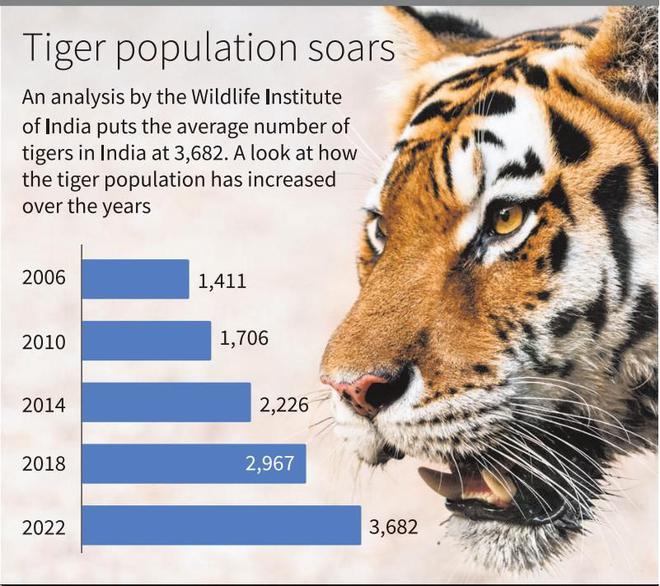India’s tiger population increased to 3,682 in 2022, up from 2,967 in 2018, according to an estimate released on Saturday. This is an upward revision from April this year, when a minimum of 3,167 animals were estimated by the Wildlife Institute of India (WII), which coordinates the quadrennial tiger census.
This also indicates significant growth over the last decade; there were 2,226 tigers reported in 2014, up from 1,706 in 2010.
Also Read | Rising Indian tiger population cause for celebration and concern
In 2022, the maximum number of tigers, 785, were reported to be in Madhya Pradesh, followed by Karnataka (563), Uttarakhand (560), and Maharashtra (444). Nearly a quarter of the tigers were reportedly outside protected areas.
India’s tigers are largely concentrated in 53 dedicated tiger reserves spread across 75,796 square km, spanning about 2.3% of India’s total land area. The reserves with the maximum number of tigers were at the Corbett National Park in Uttarakhand, which reported 260 animals, followed by Bandipur (150), and Nagarhole (141), both in Karnataka.

Enhanced protection
Central India, the Shivalik Hills, and the Gangetic plains witnessed increases in tiger population, particularly in the states of Madhya Pradesh, Uttarakhand, and Maharashtra. However, certain regions, such as the Western Ghats, experienced localised declines, needing targeted monitoring and conservation efforts. Some States — including Mizoram, Nagaland, Jharkhand, Goa, Chhattisgarh, and Arunachal Pradesh — have reported “disquieting trends”, according to a press statement from the Ministry of Environment and Forests, with smaller tiger populations.
“In general, reserves that have applied good conservation practices — such as ensuring enough prey is available for tigers — have done well,” said Qamar Qureshi, a senior scientist at the WII who is closely associated with the tiger surveys.
Approximately 35% of the tiger reserves urgently required enhanced protection measures, habitat restoration, ungulate (deer, chital, blackbuck) augmentation, and subsequent tiger reintroduction, the Environment Ministry statement added.
Counting the big cat
The estimated number of 3,582 is an average figure for a population that likely ranges between 3,167 and 3,925. Tiger numbers are estimated based on the number of unique tigers captured on camera, plus an estimate of animals that may have not been photographed.
Nearly 88% of the tigers estimated this time were captured on camera, said Mr. Qureshi, the highest in surveys so far. However, it is quite likely that future exercises may not see dramatic increases in tiger population, he cautioned. Since 2014, India’s tigers have been increasing at about 5% to 6% each year.







